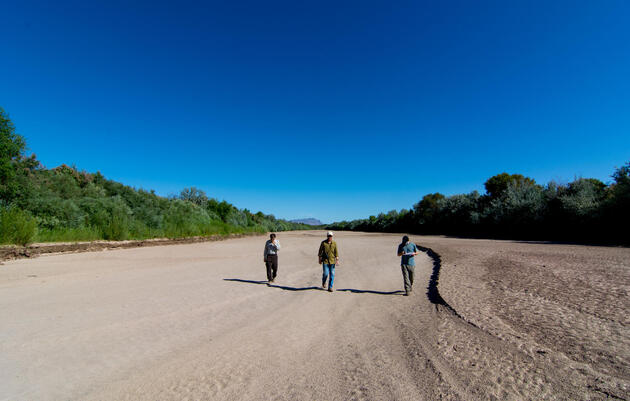The ecology of the Rio Grande was born and bred on snowpack runoff. Historically each spring, melting snow in the mountains of the basin would swell the Rio onto its floodplain and drive river processes that led to the regeneration of Cottonwood trees, spawning of Silvery Minnow and the nesting of Southwestern Willow Flycatchers. Recent hydrologic analysis suggests that during most years this “spring pulse” would have made it all the way to the Gulf of Mexico, making the snowmelt pulse the primary ecologic driver for the Rio Grande. When you think Rio Grande think big-time flooding from mid-May into late-June: freshly scoured sand bars ripe for Cottonwood seedlings to germinate, Silvery Minnows spawning on mobile river bed sand dunes, song birds nesting in saturated backwater wetlands and sloughs.
Today the spring pulse has been muted by reservoir operations, irrigation diversions, groundwater pumping and the all-too daunting specter of climate change. For our beloved Rio Grande there are some silver linings to this story. For one, we are incredibly fortunate that Cochiti Reservoir is operated for flood control. Cochiti is the sole mainstem reservoir on the Rio Grande upstream of Elephant Butte Reservoir (excluding the Rio Chama reservoirs). Because of this, the reservoir basically passes water coming into it and this water benefits from many areas of natural snow melt run off, from Southern San Juan Mountains in Colorado, to the Sangre de Cristo Range of New Mexico. A spring pulse is still part of the hydrology of this part of the Rio Grande. Where Cochiti Reservoir has altered the downstream ecology of the Rio Grande through storing of sediment and the muting of very large floods, it would be a far more dire story had this reservoir been authorized to store water for later use for farms and cities; the spring pulse would be deleted from the equation rendering Rio Grande Silvery Minnow extinct, invasive plant species the norm, and an unrecognizable, invasive dominated ecology.
As of the writing of this article in early March, snowpack water content in the Rio Grande basin is averaging between 100 and 120% of the “average” condition for this time of year. Average, like all climatic variables, is based on the previous 3 decades, in this case the period 1981-2010. You can access the latest snowpack data here. Given that that this period includes 2 decades of the past century’s wettest years (1978-1998) alongside one decade of the driest (1999-2010), this amount of snow in our watershed is a very good thing and certainly a whole lot better than last year at this time when we were hovering around 25% of average. We’ll take it—beggars can’t be choosers!
We can expect a spring pulse moving through the Rio Grande in New Mexico this spring, and this increase in water and erosion will trigger vital native ecologic processes. Today, these type of processes occur, for the most part, close to the river—on islands and bars. There are limited areas where the floodplain of the Rio Grande receives flood water anymore, primarily south of Socorro and within a few spots between Isleta and San Acacia. However, the fact that these processes remain on different scales throughout the corridor is our Rio’s hope for a vibrant future. There is much activity and opportunity to enhance these processes through connecting floodplain surfaces to modern floods, tweaking up stream reservoir operations to maximize the pulse’s magnitude and timing, delivering water to mimic flooding on historic floodplain areas, and ensuring farming communities stay verdant. This last one deserves emphasis; by ensuring that farming communities stay vibrant, we will ensure that there is a certain amount of water remaining in our Rio Grande’s channel and floodplain. As we move forward into the increasingly perilous times of drought and uncertainty, an alliance between farmers and environmentalists is essential. More ruminations and examples of this to come.
And here you have my notes from the Rio for this March of 2019. Stay tuned for more stories, reflections, and techy-info as Audubon New Mexico engages with partners up and down the Rio Grande towards a more resilient future. Feel free to e-mail me with any questions, thoughts or ideas ptashjian@audubon.org.
Happy snow-melt runoff!





